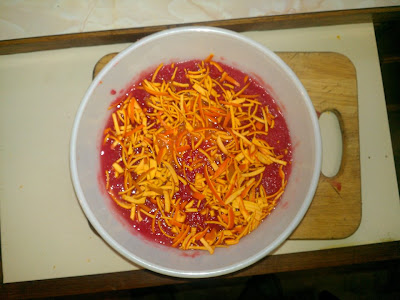Living with cancer has proven to be an interesting exercise. With the hundreds of visits to the doctor(s), poking, prodding, testing, reviewing and shooting me up with all kinds of wonder drugs that are supposed to kill this stuff off, it seems like I spend more time at Swedish Cancer Institute than anywhere else. And everybody wants to give me an injection of some kind. I feel more like a pin cushion sometimes than a human body.
Now, for every appointment, there is this ritual. Boot up the computer (well, OF COURSE!!! What would life be like if we looked at the patient instead of a computer screen - I'll write (or rant) more about that another time, perhaps - to review the patient history? This ritual consists of a drug review. "Have you changed any of your medications since you were in last?" "You mean since this morning in the other doctor's office? No." That answer isn't good enough. Now we have to spend 15 minutes reviewing each of the medications one by one as they stumble through everything I've taken since August 29th when I first started treatment. Thank goodness, my hair hasn't fallen out because I have to tell you, this is enough to make me pull it out, and if it fallen out, then what would I do in my frustration? "Have you developed any new allergies?" "You mean since 8:00 this morning? None that I know of." I try to remain in good humor, but it isn't easy some days.
Finally, it is time. They're going to give me something. Either a bag of dripping fluids, a shot of heperin in the gut, and most recently an injection of Neulasta. What is Neulasta®?
"Neulasta® is a prescription medicine called a white cell booster that helps reduce the risk of infection (initially marked by fever) in patients with some tumors receiving strong chemotherapy that decreases the number of infection-fighting white blood cells. A sufficient white blood cell count may enable your doctors to administer chemotherapy according to their treatment schedule."
This according to their website.
Now every time somebody wants to give me a shot of something, they have to explain the side effects to me. It reminds me sometimes of all those television ads that talk sweetly and serenely about all the good benefits of the drug, whatever it is. Then in a panicky, gotta get it all into the ad in less than 5 seconds, they rattle off the side effects which may include vomiting, diarrhea, constipation, heart failure, and in some cases even death. Of course, you should ask your doctor if (insert whatever drug you want to here) is right for you.
So the other day, I got out of the hospital and the oncologist told me my white cells were a little low and he wanted me to come back the next day for an injection of Neulasta. SO I came home, brought up their website and looked for the possible side effects. These include:
What are possible serious side effects of Neulasta®? Spleen Rupture. Your spleen may become enlarged and can rupture while taking Neulasta®. A ruptured spleen can cause death. The spleen is located in the upper left section of your stomach area. Call your doctor right away if you have pain in the left upper stomach area or left shoulder tip area. This pain could mean your spleen is enlarged or ruptured.
A serious lung problem called acute respiratory distress syndrome (ARDS). Call your doctor or seek emergency care right away if you have shortness of breath, trouble breathing, or a fast rate of breathing.
Serious Allergic Reactions. Neulasta® can cause serious allergic reactions. These reactions can cause shortness of breath, wheezing, dizziness, swelling around the mouth or eyes, fast pulse, sweating, and hives. If you start to have any of these symptoms, call your doctor or seek emergency care right away. If you have an allergic reaction during the injection of Neulasta®, stop the injection. Call your doctor right away.
Sickle Cell Crises. You may have a serious sickle cell crisis if you have a sickle cell disorder and take Neulasta®. Serious and sometimes fatal sickle cell crises can occur in patients with sickle cell disorders receiving Filgrastim, a medicine similar to Neulasta®. Call your doctor right away if you have symptoms of sickle cell crisis such as pain or difficulty breathing.
What are the most common side effects of Neulasta®?
The most common side effect you may experience is aching in the bones and muscles. If this happens, it can usually be relieved with a nonaspirin pain reliever, such as acetaminophen.
More information than you wanted I'm sure, and I can assure you, a whole hell of a lot more information that I wanted.
So the next day, I report for my dose. The nurse rattles off the "most common side effects" but not all the others, thank goodness. Then she asked me where I wanted it. Well, not really knowing where she was planning it, I asked her, "Well, as long as I don't have to drop my trousers, I don't really care, but since you are asking, where is the most common place to give it?" "Well," she said, "typically in the arm or the belly." Now, I went through daily heperin injections for a few weeks, every one in the belly and each one causing its own bruise. I decided that maybe I'd have it in the arm. She then informed me that a lot of her patients said that it didn't hurt as much if injected into the belly instead of the arm. "Well, okay, then. Let's go with the belly."
As she stuck me there was a slight stick and sting. Not so bad, really. Not nearly as bad as all those heperin shots. I lay there, staring at the celing and got to thinking once again about those side effects, and that got me to wondering about medical researchers and the development of drugs.
If the wonderful world of medicine is great, why can't they come up with an injection that the nurse can say, "Now this is going to sting at first and probably hurt like the dickens while I'm giving it to you. But don't worry, the only side effect of this drug is that it is going to make you feel like you are laying on a warm sunny beach in Maui for the next two days."
I'm waiting.
























